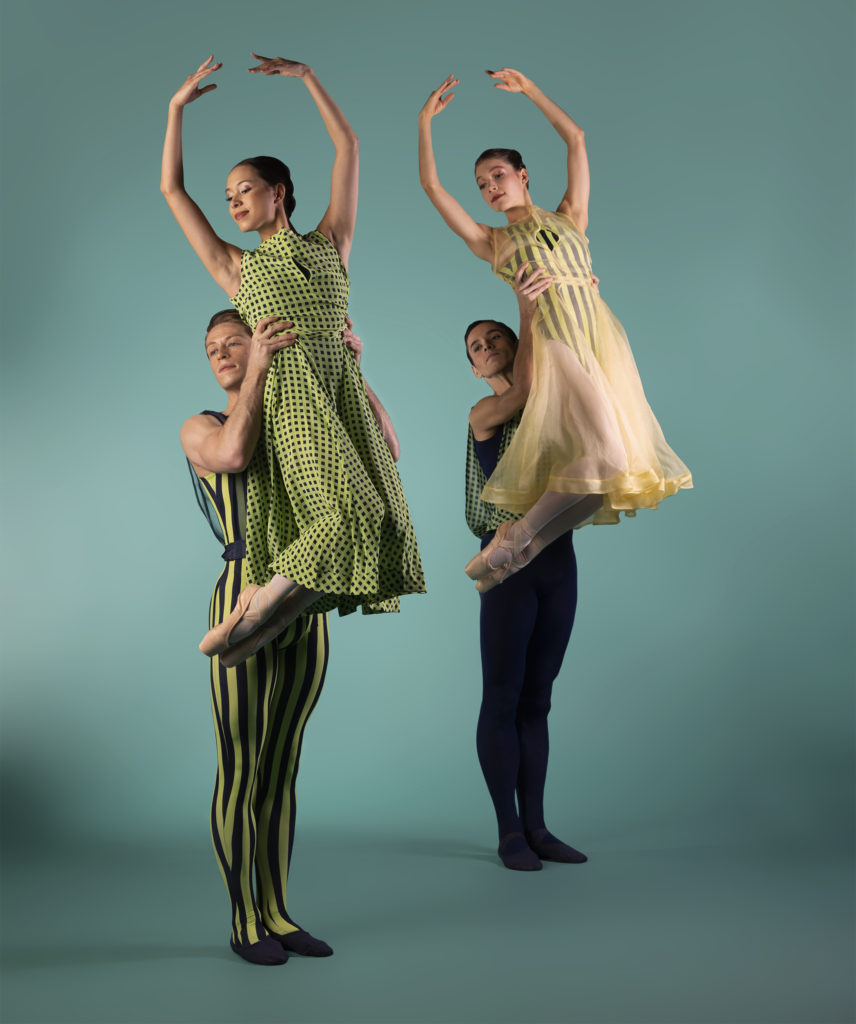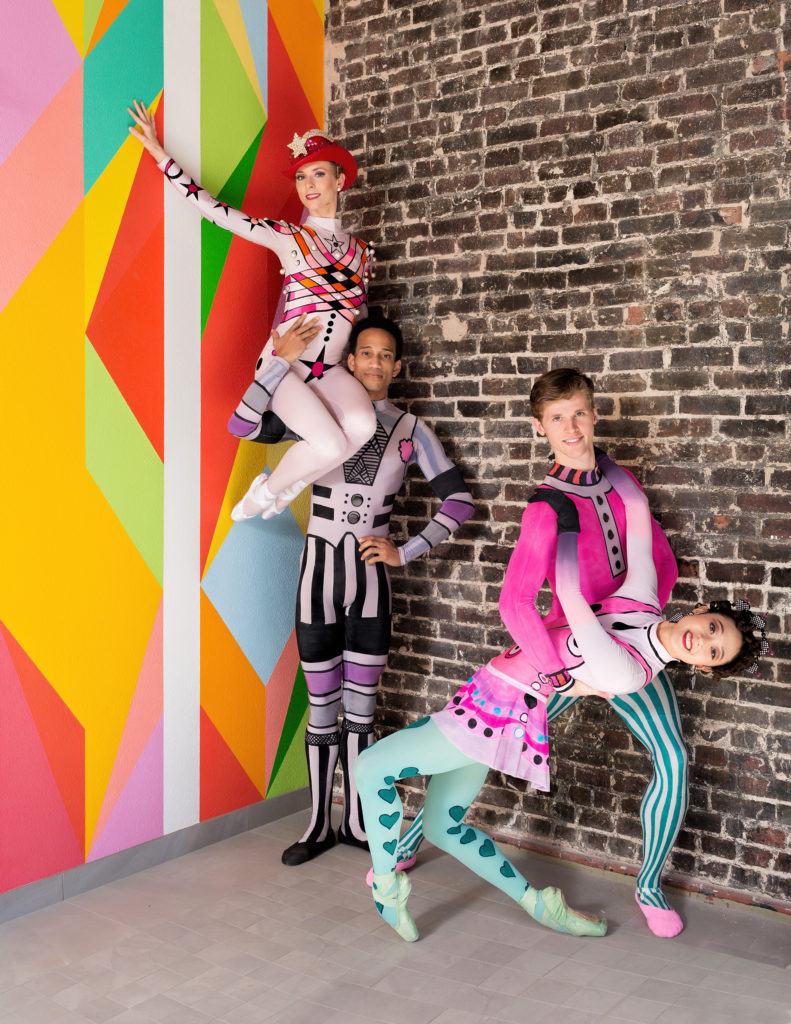
Feature
Suiting Up for Serendipity: A Peek into The Sarasota Ballet’s Wardrobe
By Sylvia Whitman | March 2022
Costumes, explains Iain Webb, director of The Sarasota Ballet, are a team collaboration, a multi-pronged conversation. A choreographer has ideas that a designer translates into cloth. Together, in coordination with set and lighting designers, they create the visual art of dance. Wardrobers add another eye and voice as they manage practical considerations like fit and shoes.
“These designers—they’re usually great characters,” says Webb. He recalls painter and designer Yolanda Sonnabend, a frequent Kenneth MacMillan collaborator, ready to rip out the interior of a costume right before the curtain went up at The Royal Ballet because “she still wasn’t quite happy with it.” Costuming has attracted the greats: Think Henri Matisse pinning cutouts on the unitard of ballerina Alicia Markova for a 1938 Ballet Russe production of Rouge et Noir.
The physical demands of ballet provide a reality check. Come a big lift in the choreography, “if there’s too much tulle, too much costume, and a dancer can’t find his partner’s waist, then something has to give,” says Webb. “That’s when the two creative teams come together, usually behind closed doors.”
So integral are costumes to the vision of a particular ballet that “the bible”—the binder of notes from the original performance—includes costume sketches and often swatches of fabric should they ever need to be recreated. Whenever possible, the company that premieres a ballet hangs onto the costumes fabricated for it, sometimes selling them but more often reusing and renting them out when other companies stage a production. It’s not surprising then that The Sarasota Ballet owns the garb and sometimes the sets for productions such as Sir Frederick Ashton’s Les Rendezvous or in-house choreographer Ricardo Graziano’s Before Night Falls.

From Steps to Stitches
The Sarasota Ballet’s last program of the season in April, Serendipitous Movement, features a trio of pieces, which means three sets of costumes.
The ballet already owns the finery for George Balanchine’s Serenade, first performed in 1934. The choreographer revised the costumes as he revised the ballet. Jerry Wolf, head of wardrobe for The Sarasota Ballet, says that costuming for traditional Balanchine ballets tends to follow (Barbara) Karinska’s designs of the ‘40s and ‘50s. “So, there’s no question mark when it comes to Balanchine, whether you make it or borrow it.”
Uncomplicated, but not easy. Costumers have to mind the skirt color, leotard color, and drape of the fabric. “I don’t know that many people realize this,” adds Wolf, “but the way the skirts are set on the leotard in Serenade, they’re higher on the left hip and lower on the right hip. There’s a little angle to the skirt, the way it attaches to the bodice, and it’s very subtle. We have to pay attention to all that.”
Mid-program, The Sarasota Ballet is dancing the company premiere of Mark Morris’s The Letter V. Like all costumes, The Letter V’s come with a story. It started with young ballet dancer Maile [pronounced Miley] Okamura moving to New York City. She found work with “a lot of downtown choreographers, meaning choreographers without a lot of money.” She could dance, but she could also sew, something she learned from her mom. So, to keep food in the fridge, she picked up costume work.
Over time, her hobby turned into a whole strand of her career. Many companies need costumes, and as a dancer herself, she understands “the needs of movement,” she says. Besides the defined waist for partnering, dancers demand “freedom to move the legs, freedom to move the torso. A dancer doesn’t want to feel the costume at all. They don’t want to be restrained or restricted. In any way. So that’s one of my priorities.”

She transitioned from ballet to modern dance and performed for more than two decades with the Mark Morris Dance Group—and still does periodically. Morris, however, like Okamura, has a foot in both modern dance and ballet. In 2015, the Houston Ballet commissioned him to choreograph The Letter V, and he tapped Okamura to design the costumes.
Okamura accompanied him to Houston to watch rehearsals and listen to the Haydn score. “He said, ‘I see stripes.’” So, Okamura used various stripes—and checks and very bold patterns–to accentuate the choreography. “Mark has just a beautiful use of symmetry, pattern, and repetition. It’s in all of his work, his modern work, his ballet work. And I know it very well.”
Okamura made drawings and browsed fabric stores for the “ethereal silk and transparency” they envisioned. The Houston Ballet costume shop built the costumes, which got their test at the final dress rehearsal. To the designers’ delight, the lines and patterns complemented the choreography, transforming the third movement circle dance into a kaleidoscope.
But the story doesn’t end there. Cyclone flooding swamped the Houston Ballet, so The Letter V costumes had to be completely rebuilt. And since the original fabric was no longer available, “we had to go through a painstaking process of digitally rebuilding it,” Okamura says.

After the blues and greens of The Letter V, Webb has chosen to wrap up Serendipitous Movement on a colorful note. Sir Kenneth Macmillan’s Elite Syncopations erupts with costumes as vibrant as the Scott Joplin score. Ian Spurling creations, they’re on loan from Birmingham Royal Ballet. Spurling “just went to town on every color that came at that point in light fiber-tip pens,” Webb says.
From Crate to Stage
Webb’s plans for an upcoming season rev wardrobe work at The Sarasota Ballet. “He will usually hire whatever ballets we don’t own or don’t want to build,” says wardrober Wolf. The company usually chooses one or two ballets to fabricate in house; for instance, Wolf collaborated with choreographer Ricardo Graziano and assistant director Margaret Barbieri on designing costumes for the world premiere of Graziano’s Sonatina last fall. Otherwise, contracts fly and costumes ship up to a year in advance of a performance. The Letter V costumes arrived months ago—but then had to make a quick roundtrip to Houston Ballet for a photoshoot.
As head of wardrobe, Wolf also analyzes the ballet and the bible, which includes who wore what when. Although ballet costumes are constructed for ease of alteration, they do come in different sizes. Wolf assigns the soloists first, then the corps parts. Even with early castings, Wolf says he waits until the first week of rehearsals to set up fitting appointments with dancers, working around their schedules. For every outfit, he takes notes and makes labels. While costumes are in residence, Wolf’s responsible for everything from storage to cleaning. Lots of cleaning, much of it by hand, to remove sweat and smeared stage makeup. Imagine washing uniforms for a team of pro athletes—all on delicate.
Tights and footwear next command Wolf’s attention. Shoes have a “ridiculously short” shelf life. Roughly $100 a pair, women’s pointe shoes last about a week of rehearsals. “It’s because the boxes are really just cardboard that’s been impregnated with different types of stiffeners. And when that shoe box that contains their toes and the end of their foot stretches out too much, or it gets too flexible, dancers can’t stand up on it. It’s a dead shoe.” Squirts of high-tech glue buy maybe one more performance. Men’s slippers last longer, but they too stretch out and lose their grip on the floor.
Each pair for performance requires coloring. Men’s flats come mostly in flesh tones, so to get them to look black for The Letter V under the stage lighting, Wolf paints them navy blue. The color doesn’t come from a can: He mixes a combo of blues, blacks, and whites—special acrylic-based paint. “And then I add some secret ingredients, which I will not reveal. Acrylic paints by nature on a fabric turn very hard. As the shoes dry, I have a way of adding something that will keep the canvas part flexible.”

Wolf says most wardrobers have their secret sauce. But his painting technique isn’t proprietary: Instead of using a brush, he cuts up a household sponge and dabs on paint, avoiding some surfaces, such as the split sole on the bottom of men’s slippers. “You can’t paint that since it would close all the pores up and create a hazard.” For Elite Syncopations, he’s matching outrageous colors—purples, yellows, oranges—in tights and shoes, mostly pointe shoes. They come standard in pink, satiny on the outside, with ribbons, so he’s dyeing them.
Wolf came to The Sarasota Ballet six seasons ago, capping a long career in theater in ballet. As a Catholic schoolboy in Portland, he danced and acted in plays and at college majored in technical theater with an emphasis in costume design. Soon he traded performing for costuming, traveling with Broadway shows like The Wiz on tour.
What’s his favorite part of wardrobing? Working with the dancers. And that moment “when we’re done.” Although Wolf stays in the wings during performances, at dress rehearsal, he can sit back and watch, just appreciating the beauty. Sometimes soft and flowy, sometimes stiff and geometric, the clothes reveal a silhouette. Often, he says, you design a costume and then strip away elements to avoid clutter, so that the audience can better appreciate the choreography through the lines of dancers’ bodies. “Although there are many ballets that have very iconic looks, the whole point in costumes for ballet is not to make some big fashion statement.”
Webb also relishes the moment before performance, imagining the audience’s anticipation. “They don’t quite know what’s behind that curtain.” When it goes up on Serendipitous Movement, Webb says, they’ll find “this program is just a visual feast of colors and styles and movement.”



You must be logged in to post a comment Login